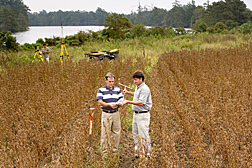This page has been archived and is being provided for reference purposes only. The page is no longer being updated, and therefore, links on the page may be invalid.
Read the magazine story to find out more. |
|
|
Careful Land Management Protects Mississippi Watersheds
By Ann PerryJanuary 6, 2009
Agricultural Research Service (ARS) scientists at the National Sedimentation Laboratory (NSL) in Oxford, Miss., are studying how farming practices and conservation strategies can improve water quality in the Yazoo River Delta and beyond.
As part of this effort, research leader Martin Locke and his colleagues have been tracking changes in the Beasley Lake watershed for more than a decade. During this time, local farmers have shifted from primarily growing cotton to producing corn, soybeans and sorghum. Other farmland has been taken out of production altogether.
Throughout this shift, the researchers monitored a range of biological, chemical and physical factors in Beasley Lake, which flows into the Yazoo River. They also evaluated runoff from edge-of-field sites and developed vegetated buffer zones and slotted inlet pipes to slow water flow and trap agricultural chemicals and sediments in field runoff.
The researchers found that Beasley Lake has improved in clarity, plankton growth levels and fish stocks over the past 11 years. Lake phosphorus levels decreased when farmers began to adopt conservation management practices, and pesticide levels also dropped significantly.
NSL ecologist Matt Moore and other scientists also carried out studies using constructed wetlands near Beasley Lake that consisted of a sediment retention pond and two vegetated wetland “cells.” Moore’s team set up 10 stations at various points within the constructed wetland system to collect water samples from a simulated runoff event.
The team drew water from Beasley Lake and mixed it with sediment and the pyrethroid insecticides lambda-cyhalothrin and cyfluthrin, which are typically used in the production of corn, cotton, soybeans, rice and wheat. Next, they conducted a carefully orchestrated “storm” and pumped the contaminated water into the constructed wetlands. Then water samples from the wetland were collected for the next 55 days.
The scientists found that the wetland vegetation trapped a significant amount of both pesticides, which suggests that constructed wetlands can help reduce the amount of chemicals that are washed out of production fields.
Read more about this research in the January 2009 issue of Agricultural Research magazine.
ARS is a scientific research agency of the U.S. Department of Agriculture.

